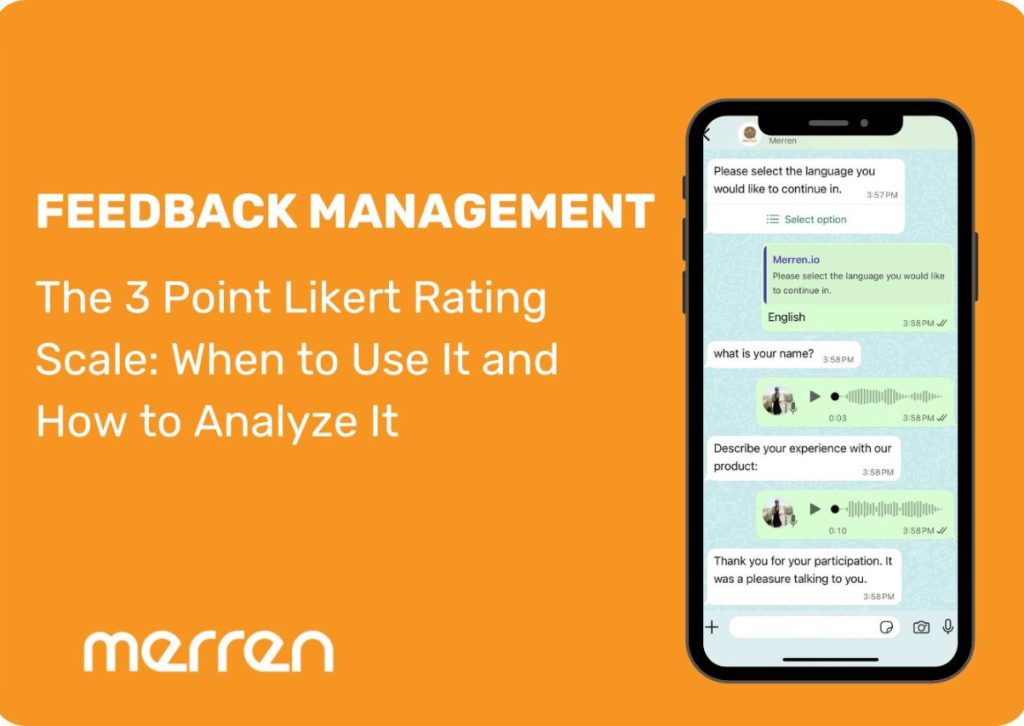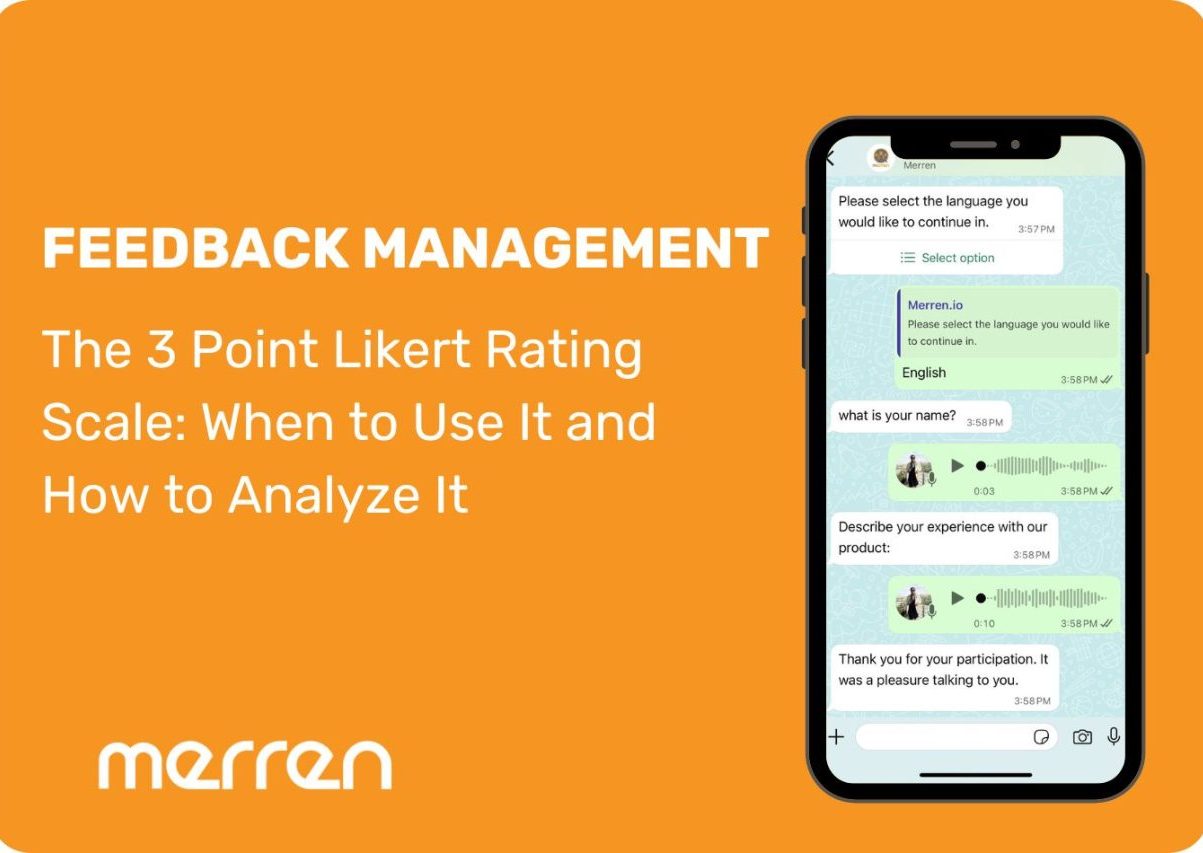There are multiple types of Likert rating scale that are used across various surveys and questionnaires. In this blog, we will discuss the standard 3-point likert rating scale and where specifically it can be used and how it is analyzed.
What is a 3 Point Likert Rating Scale?
A Likert item asks respondents to rate agreement, frequency, importance, likelihood, or a similar attitude dimension across ordered options. The 3 point Likert rating scale is the simplest version of a Likert scale that has agree / neutral / disagree or a similar triad. It’s a subset of the broader Likert family, where 5-point scale or 7-point scale options are commonly used.
Here are some common 3-point wordings
- Highly preferred / neutral / Least preferred
- Happy/ neutral / sad
- Too much / about right / too little
When is 3-point rating scale a good choice?
Use a 3-point Likert rating scale when you need the following:
- A simple pulse survey: The 3-point scale can collect precise sentiment about certain topics or experiences. It segments people categorically across ratings without the hassle of diluted sentiments.
- A simple “about right” calibration: It can be used to probe about certain products or services eg: pack size, price fairness, policy strictness.
- Conduct low- burden surveys: Ideal for limited literacy, language barriers, or time constraints where fewer options can reduce confusion.
Tips to Design Responsive 3-Point Likert Rating Scale
Label every point: Label all three points in the three-point scale clearly. Labelling clarifies the construct and reduces arbitrary mid-point use.
Match labels to the construct: Use agree–disagree for attitudes, frequency for behaviors, importance for prioritization, likelihood for intent, about right for calibration judgments.
Keep wording concrete and specific: Maintain a single idea per statement with present tense when possible. Allow people to focus on a simple emotion per topic.
Mind the middle: If neutrality would be meaningful in your context (e.g., truly indifferent customers), include it; if you need a choice, use even-point (2 or 4+) to force direction though that’s no longer a 3-point scale.
Use examples: For “about right” judgments, borrow from the vetted 3-point anchors above to maintain clarity and comparability.
Use responsive survey channels: Survey channels such as WhatsApp survey, chatbot, messenger surveys can instantly capture sentiments on the three-point rating scale. The responsive survey channels have a high open rate.
Example of 3-Point Likert Rating Scale Questions
- Emoji: Happy/ Neutral / Sad. Question: How do you feel after our service?
- Agreement (attitude): Agree / Neutral / Disagree. Question: The onboarding emails were helpful
- Frequency (behavior): Often / Sometimes / Never (or Frequently / Occasionally / Never). Question: How often do you purchase from our website?
- Importance (prioritization): Important / Neither / Not important.
- Likelihood (intent): Likely / Unsure / Unlikely.
- About-right judgment: Too much / About right / Too little (price fairness, packaging, notifications).
3-Point Rating Vs. 5-Point Rating Or 7-Point Rating: Choosing The Right Likert Scale
5–7 point scales are most prevalent in commercial survey tools and often yield higher reliability than 3-point. 1-10 rating scale is another commonly used scale in commercial surveys. Use 3 when simplicity is the priority and nuance is secondary.
When to use | Three-point scale | 5-point or 7-point scale |
Pulse survey for quick decision | Direction is enough to decide next step | You need rank-ordering or initiative prioritization |
Hard-to-reach respondents | You must minimize time and fatigue | Respondents can handle nuance without drop-off rates |
Psychometric | Not too ideal due to reliability concerns | You need reliable scales and sensitivity |
“About right” calibrations | Middle is truly meaningful | When you suspect polarization or asymmetry |
Analyze Responses on the 3-Point Likert Rating Scale
Even with just three categories, you can extract actionable signals. For a 3‑point scale like Disagree–Neutral–Agree, keep analysis clear, fast, and decision-focused.
1. Set up your data
Code answers the same way: Disagree = 1, Neutral = 2, Agree = 3. Treat it as ordinal data. Start with counts and percentages; use averages only if explained.
2. Show the distribution, not just a score
Report how many people choose from one of the three options. Display it in a bar or a circular chart for visual reference. Share median or mode; add mean only with context.
3. Build smart composites
- If several items measure one thing (like ease or support), average or sum them.
- Reverse-code negative items so higher = better.
- Check reliability (e.g., Cronbach’s alpha) before tracking.
4. Keep inference fit-for-purpose
- Compare groups → chi-square test.
- Correlate items → Spearman rank.
- Predict outcomes → ordinal logistic regression.
- For reliable composites, linear models are okay.
6. Be transparent about trade‑offs
3‑point scales are quick and reduce survey fatigue. However, they lose nuance and may lower reliability. Use them for pulse surveys for smaller experiences or quick replies. For detailed analysis and in-depth experiences, use a 5-point or 7-point rating scale.
7) Reporting checklist
Share the CX dashboard chart on the number of people who have completed the 3-point rating scale survey. Segment it with filters (as per demography, gender etc). Show the number of people who agree vs disagree in a presentable chart.
Run 3-Point Likert Scale Across Interactive Survey Channels
Create interactive standard three-point rating scale and publish it with Merren. Select interactive survey channels that give you the highest response rate:
WhatsApp surveys, Facebook messenger surveys, survey chatbot and dynamic emails.
Sign up here for a 14 day free trial and see how you can 10x your response rate minus the technical know-how.


